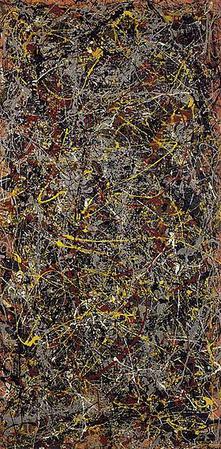Abstract painting is not a single movement, it has a longer history than many think and includes many styles, it can be traced back to 15th. century Russian icons in the Byzantine style that have abstract elements, up until the present day where many abstract artists are working. The Russian born Madame Blavatsky painted abstracts, working in the latter part of the 19th. century, she was a theosophist who painted her interpretations of dreams, inspired by themes she studied from ancient Eastern religions, she wished to return to ancient truths, believed in the transmigration of the soul and held a belief in an ante-natal state of existence, theosophists rejected dogma, their aim was to promote love, understanding and compassion. Then there was Helma af Klimt in Sweden, Emilie Alberg brought her work to our attention in a thread published on the site last year, Helma thought that she was in touch with spirits and that she received messages from the ‘High Master’ from an astral plain, she wrote copious notes to guide her paintings which she hoped would help to change society for the better. In England in the 1930s the artist Ben Nicholson painted abstracts, his wife was the sculptor Barbara Hepworth. Vassily Kandinsky, Piet Mondrian and the Russian artist Malevich also painted abstracts, all very different in style from each other, they were searchig for a fourth dimension which had ‘overtones of Theosophy and monism which saw the untity of all things’ both spiritul and material. Kandinsky painting in Germany felt that colours had spiritual qualities, for example yellow as a typical earthly quality, disturbing; blue is deep, supernatural, a typical heavenly colour; green, a mixture of blue and yellow denotes stillness, peace; red symbolised being alive and confident. He wrote Concerning the Spiritual in Art, he attempted to depict a gravity free and direction-less space in his work, Paul Klee painted abstracts, he also had strong spiritual beliefs. In the 1950s and 1960s Bridget Riley in England painted what was called Op Art, composed of coloured lines, she continues to work in this style she feels that there is an energy and flow depicted in her work.
I have chosen an abstract work by the artist Jackson Pollock born in 1912 in Wyoming, called No.5 painted in 1948. Pollock was adopted after the death within a short time of both his parents, he grew up in Arizona and California, he then moved to New York, a central hub for artists, no longer Paris as had been the case in the early 1900s, he exhibited in the Peggy Guggenheim Gallery. Pollock was one of the most influential artists in 1950s American, he is called an Abstract Expressionist painter, he married another abstract artist, Lee Krasner who gave him moral support. His canvases were very large, sometimes twenty feet wide, painted while spread on his studio floor or on the ground on which he dripped, splashed and trailed liquid paint, a paint invented and sold commercially since 1936, he would apply the paint with hardened brushes, sticks , trowels or whatever he thought suitable, building up areas, creating depth gradually. He thought on a huge scale, many thought he painted without reason, that it was chaotic – it may in fact be possible that ‘he had an intuition of the nature of chaotic motion’ he ends up with a controlled structure, balanced and harmonious containing a range of textures, often described as a visual symphony. Pollock used the force of his whole body to apply the paint. He walked slowly around the canvas sometimes on the canvas, totally absorbed until he felt the work complete, he often worked with black paint or up to seven colours creating vibrating space, his work has been described as capturing the American dream, the canvas likened to a vast screen, an American wilderness.
Pollock fought to find his own voice against all the criticism that came his way, he was also fighting to overcome alcoholism. Between the years 1938 and 1941 he underwent Jungian psychotherapy in a bid to recover, his work is said to have ben influenced by Jungian concepts and archetypes – ‘universal, archaic patterns and images that derive from the collective unconscious’. This style of painting has been called ‘drip painting’, Pollock acknowledged that he was influenced by the work of the Ukrainian artist Janet Sobel working in the 1940s. Fractals have been seen in his work where small areas are repeated reducing in size, each area similar to the whole work.
Painting No. 5 sold in 2006 for 140 million dollars, it has become an investment, helped no doubt by the fact that it was a new kind of painting. Sadly his golden period ended in 1951, he may have had bi-polar disorder, he had rages and was bitter at times, he began drinking again, his best work was behind him, he died in a car accident in 1956 aged forty four, driving while intoxicated.
In a recent television programme Dr. James Fox noted that the time around the time Pollock was working America was buzzing with creativity, Jack Kerouac wrote On the Road, a stream of consciousness novel and jazz musicians such as Thelonious Monk were composing and playing.
Information and image from wikipedia and other web sites.

